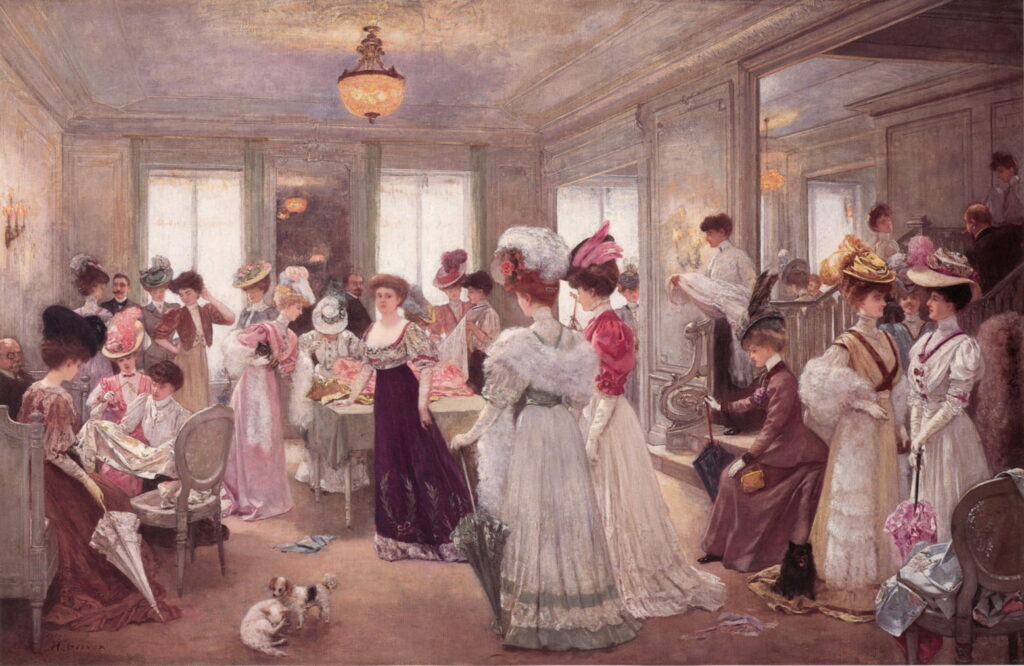Urban Revolutionaries: 10 Rags to riches

Although few of those who migrated to the towns and cities from the countryside prospered as a result, there were sufficient examples to lure others to take their chances. For a young woman, success could come through the growing world of fashion.
Christian Krohg (1852–1925), Tired (1885), oil on canvas, 79.5 x 61.5 cm, Nasjonalgalleriet, Oslo, Norway. Wikimedia Commons.
The foot of the ladder was the greatest challenge: how to make the break from the worn-out worker shown in Christian Krohg’s Tired from 1885. This young seamstress was one of the many thousands who worked at home at that time, toiling for long hours by lamplight for a pittance. A few of them had the good fortune to be discovered and taken up into a small dressmaker’s.
Moritz Stifter (1857–1905), The New Dress (1889), oil on panel, 30.5 x 40 cm, location not known. Wikimedia Commons.
They might then enter the world of Moritz Stifter’s New Dress from 1889. Every face is smiling here, some perhaps a little vacuously, as an affluent young woman tries on a new dress, with its incredibly small waist. Although this room is full of fabric and the trappings of dressmaking, including the mandatory sewing machine, no one actually appears to be making anything.
Edgar Degas (1834–1917), The Millinery Shop (1879/86), oil on canvas, 100 x 110.7 cm, The Art Institute of Chicago, Chicago, IL. Wikimedia Commons.
A few specialised in making hats, as shown in Edgar Degas’ The Millinery Shop (1879/86). While husbands and partners were expected to pay for a woman’s hats, their choice was hers, and hers alone.
Jean Béraud (1849–1935), The Milliner on the Champs Elysées (year not known), oil on canvas, 45.1 × 34.9 cm, Private collection. Wikimedia Commons.
Jean Béraud’s fashionably-dressed Milliner on the Champs Elysées is enjoying her success, and carrying her work in two large hatboxes. She has also attracted the attention of the well-dressed man in a top hat behind and to the left of her.
Paul Signac (1863-1935), Les Modistes (Two Milliners in the Rue du Caire, Paris) (Op 127) (1885-86), oil on canvas, 111.8 x 89 cm, Private collection. Wikimedia Commons.
Les Modistes (Two Milliners in the Rue du Caire, Paris) from 1885-86 is one of Paul Signac’s transitional paintings to Seurat’s Divisionism. These two young milliners are busy making fashionable hats and making their way into bourgeois life.
Pierre-Georges Jeanniot (1848–1934), At the Milliner (1901), oil on canvas, 54.5 x 81.5 cm, Private collection. Wikimedia Commons.
Pierre-Georges Jeanniot’s At the Milliner (1901) shows the milliner in a mirror at the right.
Henri Gervex (1852–1929), Five Hours at Paquin’s (1906), oil on canvas, 260 x 172.7 cm, location not known. Wikimedia Commons.
Millinery was one of the staples of fashion houses like that of Paquin, whose success was characteristic of the late nineteenth century, and shown in Henri Gervex’s Five Hours at Paquin’s from 1906.
Pierre-Georges Jeanniot (1848–1934), The Ritz Hôtel, Paris (1908), further details not known. Wikimedia Commons.
The purpose of these expensive hand-made hats was for show, when the lady was seen in appropriate surroundings. Jeanniot’s painting of the patrons of one of the most fashionable hotels in Paris shows all the hats out on parade in the inner garden of the Paris Ritz in fine weather.
Jean Béraud (1849–1935), Workers leaving the Maison Paquin (1907), further details not known. The Athenaeum.
Béraud’s Workers leaving the Maison Paquin (1907) shows the ladies who worked in Jeanne Paquin’s highly successful fashion house in the Rue de la Paix, as they left work at the end of the day.
A select few were fortunate enough to marry into the middle class and forge a more secure future for themselves.
Jean Béraud (1849–1935), After the Service at the Church of Sainte-Trinité (the ‘American Cathedral’, Avenue George-V, Paris) (c 1900), oil on canvas, others details not known. Wikimedia Commons.
Béraud’s After the Service at the Church of Sainte-Trinité (the ‘American Cathedral’) (c 1900) shows affluent Franco-American society at the turn of the century, and the prominence of hats and clothes.




